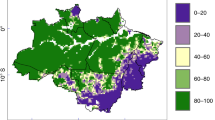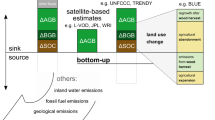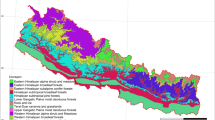Abstract
Carbon stocks in vegetation have a key role in the climate system1,2,3,4. However, the magnitude, patterns and uncertainties of carbon stocks and the effect of land use on the stocks remain poorly quantified. Here we show, using state-of-the-art datasets, that vegetation currently stores around 450 petagrams of carbon. In the hypothetical absence of land use, potential vegetation would store around 916 petagrams of carbon, under current climate conditions. This difference highlights the massive effect of land use on biomass stocks. Deforestation and other land-cover changes are responsible for 53–58% of the difference between current and potential biomass stocks. Land management effects (the biomass stock changes induced by land use within the same land cover) contribute 42–47%, but have been underestimated in the literature. Therefore, avoiding deforestation is necessary but not sufficient for mitigation of climate change. Our results imply that trade-offs exist between conserving carbon stocks on managed land and raising the contribution of biomass to raw material and energy supply for the mitigation of climate change. Efforts to raise biomass stocks are currently verifiable only in temperate forests, where their potential is limited. By contrast, large uncertainties hinder verification in the tropical forest, where the largest potential is located, pointing to challenges for the upcoming stocktaking exercises under the Paris agreement.
This is a preview of subscription content, access via your institution
Access options
Access Nature and 54 other Nature Portfolio journals
Get Nature+, our best-value online-access subscription
$29.99 / 30 days
cancel any time
Subscribe to this journal
Receive 51 print issues and online access
$199.00 per year
only $3.90 per issue
Buy this article
- Purchase on Springer Link
- Instant access to full article PDF
Prices may be subject to local taxes which are calculated during checkout



Similar content being viewed by others
References
Bloom, A. A., Exbrayat, J.-F., van der Velde, I. R., Feng, L. & Williams, M. The decadal state of the terrestrial carbon cycle: global retrievals of terrestrial carbon allocation, pools, and residence times. Proc. Natl Acad. Sci. USA 113, 1285–1290 (2016)
Houghton, R. A. Balancing the global carbon budget. Annu. Rev. Earth Planet. Sci. 35, 313–347 (2007)
Saugier, B., Roy, J. & Mooney, H. A. in Terrestrial Global Productivity (eds Roy, J., Saugier, B. & Mooney, H. A. ) 543–557 (Academic, 2001)
IPCC. Climate Change 2013: The Physical Science Basis. (eds Stocker, T. F. et al.) (Cambridge Univ. Press, 2013)
GTOS. Biomass (FAO, 2009)
Saatchi, S. S. et al. Benchmark map of forest carbon stocks in tropical regions across three continents. Proc. Natl Acad. Sci. USA 108, 9899–9904 (2011)
Baccini, A. et al. Estimated carbon dioxide emissions from tropical deforestation improved by carbon-density maps. Nat. Clim. Change 2, 182–185 (2012)
Thurner, M. et al. Carbon stock and density of northern boreal and temperate forests. Glob. Ecol. Biogeogr. 23, 297–310 (2014)
Mitchard, E. T. et al. Uncertainty in the spatial distribution of tropical forest biomass: a comparison of pan-tropical maps. Carbon Balance Manag. 8, 10 (2013)
Mitchard, E. T. A. et al. Markedly divergent estimates of Amazon forest carbon density from ground plots and satellites. Glob. Ecol. Biogeogr. 23, 935–946 (2014)
Avitabile, V. et al. An integrated pan-tropical biomass map using multiple reference datasets. Glob. Change Biol. 22, 1406–1420 (2016)
Hansis, E., Davis, S. J. & Pongratz, J. Relevance of methodological choices for accounting of land use change carbon fluxes. Global Biogeochem. Cycles 29, 1230–1246 (2015)
Arneth, A. et al. Historical carbon dioxide emissions caused by land-use changes are possibly larger than assumed. Nat. Geosci. 10, 79–84 (2017)
Scholes, R. J., Monteiro, P. M. S., Sabine, C. L. & Canadell, J. G. Systematic long-term observations of the global carbon cycle. Trends Ecol. Evol. 24, 427–430 (2009)
FAO. Global Forest Resources Assessment 2010 (FAO, 2010)
Pan, Y. et al. A large and persistent carbon sink in the world’s forests. Science 333, 988–993 (2011)
Haberl, H., Erb, K.-H. & Krausmann, F. Human appropriation of net primary production: patterns, trends, and planetary boundaries. Annu. Rev. Environ. Resour. 39, 363–391 (2014)
Erb, K.-H. et al. Biomass turnover time in terrestrial ecosystems halved by land use. Nat. Geosci. 9, 674–678 (2016)
Haberl, H. et al. Quantifying and mapping the human appropriation of net primary production in earth’s terrestrial ecosystems. Proc. Natl Acad. Sci. USA 104, 12942–12947 (2007)
Kaplan, J. O. et al. Holocene carbon emissions as a result of anthropogenic land cover change. Holocene 21, 775–791 (2011)
Tian, H. et al. Global patterns and controls of soil organic carbon dynamics as simulated by multiple terrestrial biosphere models: current status and future directions. Global Biogeochem. Cycles 29, 775–792 (2015)
Malhi, Y. The productivity, metabolism and carbon cycle of tropical forest vegetation. J. Ecol. 100, 65–75 (2012)
Allen, C. D. et al. A global overview of drought and heat-induced tree mortality reveals emerging climate change risks for forests. For. Ecol. Manage. 259, 660–684 (2010)
Holtsmark, B. Harvesting in boreal forests and the biofuel carbon debt. Clim. Change 112, 415–428 (2012)
Schulze, E.-D., Körner, C., Law, B. E., Haberl, H. & Luyssaert, S. Large-scale bioenergy from additional harvest of forest biomass is neither sustainable nor greenhouse gas neutral. Glob. Change Biol. Bioenergy 4, 611–616 (2012)
Le Toan, T. et al. The BIOMASS mission: mapping global forest biomass to better understand the terrestrial carbon cycle. Remote Sens. Environ. 115, 2850–2860 (2011)
Neeck, S. P. The NASA Earth Science Flight Program: an update. In Sensors, Systems, and Next-Generation Satellites XIX Vol. 9639, 963907 (SPIE Remote Sensing, 2015)
Cai, X., Zhang, X. & Wang, D. Land availability for biofuel production. Environ. Sci. Technol. 45, 334–339 (2011)
Searchinger, T. D. et al. High carbon and biodiversity costs from converting Africa’s wet savannahs to cropland. Nat. Clim. Change 5, 481–486 (2015)
Erb, K.-H. et al. A comprehensive global 5 min resolution land-use data set for the year 2000 consistent with national census data. J. Land Use Sci. 2, 191–224 (2007)
FAOSTAT. Statistical Databases. http://faostat.fao.org (2015)
Monfreda, C., Ramankutty, N. & Foley, J. A. Farming the planet: 2. Geographic distribution of crop areas, yields, physiological types, and net primary production in the year 2000. Glob. Biogeochem. Cycles 22, GB1022 (2008)
Zomer, R. J. et al. Global tree cover and biomass carbon on agricultural land: the contribution of agroforestry to global and national carbon budgets. Sci. Rep. 6, 29987 (2016)
Bartholomé, E. & Belward, A. S. GLC2000: a new approach to global land cover mapping from Earth observation data. Int. J. Remote Sens. 26, 1959–1977 (2005)
Sanderson, E. W. et al. The human footprint and the last of the wild: the human footprint is a global map of human influence on the land surface, which suggests that human beings are stewards of nature, whether we like it or not. Bioscience 52, 891–904 (2002)
Potapov, P. et al. Mapping the world’s intact forest landscapes by remote sensing. Ecol. Soc. 13, 51 (2008)
FAO. Global Ecological Zoning for the Global Forest Resources Assessment, 2000 (FAO, 2001)
Olson, D. M. et al. Terrestrial ecoregions of the world: a new map of life on Earth: a new global map of terrestrial ecoregions provides an innovative tool for conserving biodiversity. Bioscience 51, 933–938 (2001)
Ramankutty, N. & Foley, J. A. Estimating historical changes in global land cover: croplands from 1700 to 1992. Glob. Biogeochem. Cycles 13, 997–1027 (1999)
DiMiceli, C. M . et al. Annual global automated MODIS vegetation continuous fields (MOD44B) at 250 m spatial resolution for data years beginning day 65, 2000–2010, collection 5, percent tree cover http://glcf.umd.edu/data/vcf/ (Univ. Maryland, 2011)
Simard, M., Pinto, N., Fisher, J. B. & Baccini, A. Mapping forest canopy height globally with spaceborne lidar. J. Geophys. Res. 116, G04021 (2011)
Fang, J. et al. Overestimated biomass carbon pools of the Northern mid- and high latitude forests. Clim. Change 74, 355–368 (2006)
Zika, M. & Erb, K. H. The global loss of net primary production resulting from human-induced soil degradation in drylands. Ecol. Econ. 69, 310–318 (2009)
Santoro, M. et al. Forest growing stock volume of the Northern Hemisphere: spatially explicit estimates for 2010 derived from Envisat ASAR. Remote Sens. Environ. 168, 316–334 (2015)
Bondeau, A. et al. Modelling the role of agriculture for the 20th century global terrestrial carbon balance. Glob. Change Biol. 13, 679–706 (2007)
Lieth, H. in Primary Productivity of the Biosphere 237–263 (Springer, 1975)
Zhao, M., Heinsch, F. A., Nemani, R. R. & Running, S. W. Improvements of the MODIS terrestrial gross and net primary production global data set. Remote Sens. Environ. 95, 164–176 (2005)
Ruesch, A . & Gibbs, H. K. New IPCC Tier-1 global biomass carbon map for the year 2000. http://www.citeulike.org/group/15400/article/12205382 (2008)
Tüxen, R. Die heutige potentielle natürliche Vegetation als Gegenstand der Vegetationskartierung. Angewandte Pflanzensoziologie 13, 5–42 (1956)
ESA & UCLouvain. Globcover. http://due.esrin.esa.int/page_globcover.php. (2010)
Egglestone, H. S ., Buendia, L ., Miwa, K. & Ngara, T. IPCC Guidelines for National Greenhouse Gas Inventories, Prepared by the National Greenhouse Gas Inventories Programme (IGES, 2006)
Amthor, J. S. et al. Boreal forest CO2 exchange and evapotranspiration predicted by nine ecosystem process models: intermodel comparisons and relationships to field measurements. J. Geophys. Res. 106, 33623–33648 (2001)
Jarvis, P. G., Saugier, B. & Schulze, E.-D . in Terrestrial Global Productivity (eds. Roy, J., Saugier, B. & Mooney, H. A. ) 211–244 (Academic, 2001)
Ajtay, G. L., Ketner, P. & Duvigneaud, P. in The Global Carbon Cycle, SCOPE Report 13 129–182 (John Wiley & Sons, 1979)
Cannell, M. G. R. World Forest Biomass and Primary Production Data (Academic, 1982)
West, P. C. et al. Trading carbon for food: global comparison of carbon stocks vs. crop yields on agricultural land. Proc. Natl Acad. Sci. USA 107, 19645–19648 (2010)
Hurteau, M. D., Koch, G. W. & Hungate, B. A. Carbon protection and fire risk reduction: toward a full accounting of forest carbon offsets. Front. Ecol. Environ. 6, 493–498 (2008)
Houghton, R. A., Hackler, J. L. & Lawrence, K. T. Changes in terrestrial carbon storage in the United States. 2: The role of fire and fire management. Glob. Ecol. Biogeogr. 9, 145–170 (2000)
Saatchi, S. et al. Seeing the forest beyond the trees. Glob. Ecol. Biogeogr. 24, 606–610 (2015)
Pongratz, J., Reick, C. H., Raddatz, T. & Claussen, M. Effects of anthropogenic land cover change on the carbon cycle of the last millennium. Glob. Biogeochem. Cycles 23, GB4001 (2009)
DeFries, R. S., Field, C. B., Fung, I., Collatz, G. J. & Bounoua, L. Combining satellite data and biogeochemical models to estimate global effects of human-induced land cover change on carbon emissions and primary productivity. Glob. Biogeochem. Cycles 13, 803–815 (1999)
Strassmann, K. M., Joos, F. & Fischer, G. Simulating effects of land use changes on carbon fluxes: past contributions to atmospheric CO2 increases and future commitments due to losses of terrestrial sink capacity. Tellus B Chem. Phys. Meteorol. 60, 583–603 (2008)
Olofsson, J. & Hickler, T. Effects of human land-use on the global carbon cycle during the last 6,000 years. Veg. Hist. Archaeobot. 17, 605–615 (2008)
Stocker, B. D., Feissli, F., Strassmann, K. M., Spahni, R. & Joos, F. Past and future carbon fluxes from land use change, shifting cultivation and wood harvest. Tellus B Chem. Phys. Meteorol. 66, 23188 (2014)
Carcaillet, C. et al. Holocene biomass burning and global dynamics of the carbon cycle. Chemosphere 49, 845–863 (2002)
Kleinen, T., Brovkin, V. & Schuldt, R. J. A dynamic model of wetland extent and peat accumulation: results for the Holocene. Biogeosciences 9, 235–248 (2012)
Yu, Z. Holocene carbon flux histories of the world’s peatlands: global carbon-cycle implications. Holocene 21, 761–774 (2011)
Sabine, C. L. et al. The oceanic sink for anthropogenic CO2 . Science 305, 367–371 (2004)
Bazilevich, N. I., Rodin, L. Y. & Rozov, N. N. Geographical aspects of biological productivity. Sov. Geogr. 12, 293–317 (1971)
Olson, J. S., Watts, J. A. & Allison, L. J. Carbon in Live Vegetation of Major World Ecosystems (Oak Ridge National Laboratory, 1983)
Shevliakova, E. et al. Carbon cycling under 300 years of land use change: importance of the secondary vegetation sink. Glob. Biogeochem. Cycles 23, GB2022 (2009)
Pan, Y., Birdsey, R. A., Phillips, O. L. & Jackson, R. B. The structure, distribution, and biomass of the world’s forests. Annu. Rev. Ecol. Evol. Syst. 44, 593–622 (2013)
Prentice, I. C., Harrison, S. P. & Bartlein, P. J. Global vegetation and terrestrial carbon cycle changes after the last ice age. New Phytol. 189, 988–998 (2011)
Hurtt, G. et al. Harmonization of land-use scenarios for the period 1500–2100: 600 years of global gridded annual land-use transitions, wood harvest, and resulting secondary lands. Clim. Change 109, 117–161 (2011)
Whittaker, R. H. & Likens, G. E. Primary production: the biosphere and man. Hum. Ecol. 1, 357–369 (1973)
Post, W. M., King, A. W. & Wullschleger, S. D. Historical variations in terrestrial biospheric carbon storage. Glob. Biogeochem. Cycles 11, 99–109 (1997)
Esser, G. Sensitivity of global carbon pools and fluxes to human and potential climatic impacts. Tellus B Chem. Phys. Meteorol. 39, 245–260 (1987)
Potter, C. S. Terrestrial biomass and the effects of deforestation on the global carbon cycle results from a model of primary production using satellite observations. Bioscience 49, 769–778 (1999)
Hall, D. O. & Scurlock, J. M. O. in Photosynthesis and Production in a Changing Environment. A field and Laboratory Manual (eds Hall, D. O. et al.) Appendix 2, 464 (Springer, 1993)
Amthor, J. S . et al. Terrestrial Ecosystem Responses to Global Change: A Research Strategy. (Oak Ridge National Laboratory, 1998)
IPCC Land Use, Land-Use Change and Forestry (eds Watson, R. T. et al.) (IPCC, Cambridge Univ. Press, 2000)
Acknowledgements
Funding from the European Research Council (ERC-2010-stg-263522 ‘LUISE’), the European Commission (H2020-EO-2014-640176 ‘BACI’), the German Research Foundation’s Emmy Noether Program (PO 1751/1-1), GlobBiomass project of the European Space Agency (4000113100/14/I-NB), the NOVA grant UID/AMB/04085/2013, the Amsterdam Academic Alliance (AAA) and the Vetenskapsrådet grant 621-2014-4266 of the Swedish Research Council are acknowledged. We thank A. Baccini, A. S. Ruesch, S. Saatchi and P. C. West for making their data layers publicly available. K.H.-E. is grateful for the support by K. Kowalski. This research contributes to the Global Land Programme (https://glp.earth/).
Author information
Authors and Affiliations
Contributions
K.-H.E., T.K., C.P. and S.L. designed the study and performed the research, A.L.S.B., N.C., T.F., S.G., H.H., C.L., M.N., M.T. and J. P. contributed and analysed data and results, and all authors contributed substantially to the analysis, interpretation of results and writing of the manuscript.
Corresponding author
Ethics declarations
Competing interests
The authors declare no competing financial interests.
Additional information
Reviewer Information Nature thanks A. Friend, R. Houghton and the other anonymous reviewer(s) for their contribution to the peer review of this work.
Publisher's note: Springer Nature remains neutral with regard to jurisdictional claims in published maps and institutional affiliations.
Extended data figures and tables
Extended Data Figure 1 Estimates of the potential and actual biomass stocks from the literature and this study.
a, Potential biomass stocks. b, Actual biomass stocks. Datasets from the following studies were used: (1)69, (2)3, (3)70, (4)54, (5)20, (6)71, (7)72, (8)73, (9)56, (10)74, (11)75, (12)76, (13)77, (14)78, (15)79, (16)48, (17)80, (18)81 (19)72. The darker shaded columns are those used in this study (for details see text).
Extended Data Figure 2 Conceptual and methodological design of the study.
a, The relation of prehistoric (α), potential (β) and actual (γ) biomass stocks. Potential vegetation refers to the vegetation that would prevail in the absence of land use but with current environmental conditions. As both actual and potential vegetation refer to the same environmental conditions, their difference must not be interpreted as a stock change between two points in time. As a consequence, the comparison of potential and actual biomass stocks does not refer to the cumulative net balance of all fluxes from and to the biomass compartment (for example, induced by land-use and environmental changes). Rather, it isolates and quantifies the effect of land use on biomass stocks. The effect of land use consists of two components, that is, cumulative land-use emissions and land-use-induced reductions in carbon sequestration that would result from environmental changes. For more information and discussion, see Supplementary Information. b, Conceptual attribution of the difference between potential and actual biomass stocks to land conversion and land management. Error bars reflect the divergence among datasets for the respective vegetation types and indicate the determination of verification volumes.
Extended Data Figure 4 Potential biomass stock maps used in the study.
a, IPCC-based, FRA-adjusted map. b, IPCC-based map adjusted using data from ref. 16. c, Cell-based minima of classic data. d, Cell-based maxima of classic data. e, Remote-sensing-derived map. f, Map from ref. 56. The same mask for unproductive areas has been applied to all maps. For details and sources for maps in a–e, see Methods.
Extended Data Figure 5 Land-use-induced difference in potential and actual biomass stocks, uncertainty of input data and vegetation units used in the study.
a, Impact of land-cover conversion. b, Impact of land management. a, b, Maps are based on the FRA-based actual biomass-stock map and the corresponding, IPCC-based FRA-adjusted potential carbon-stock map. c, Standard deviation of potential biomass-stock maps (n = 6). d, Standard deviation of actual biomass-stock maps (n = 7). e, Intersect of all three37,38,39 biome maps used in the ecozone approaches and for the construction of the remote-sensing-based potential biomass-stock map. f, FAO ecozones37 used for the aggregation of results. The ‘tropical core’ consists of humid rainforests. The tropical zones contain moist deciduous forests, dry forests, tropical shrubs, savannahs and hot deserts.
Supplementary information
Supplementary Information
This file contains supporting text “Contextualizing the difference of potential and actual carbon stocks with global carbon balance accounts”, supporting tables 1-3 and additional literature. (PDF 755 kb)
Rights and permissions
About this article
Cite this article
Erb, KH., Kastner, T., Plutzar, C. et al. Unexpectedly large impact of forest management and grazing on global vegetation biomass. Nature 553, 73–76 (2018). https://doi.org/10.1038/nature25138
Received:
Accepted:
Published:
Issue Date:
DOI: https://doi.org/10.1038/nature25138
Comments
By submitting a comment you agree to abide by our Terms and Community Guidelines. If you find something abusive or that does not comply with our terms or guidelines please flag it as inappropriate.



